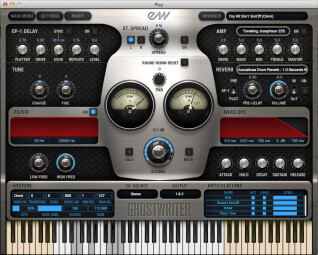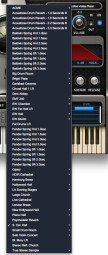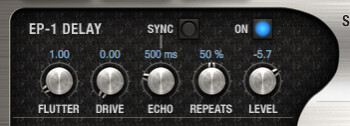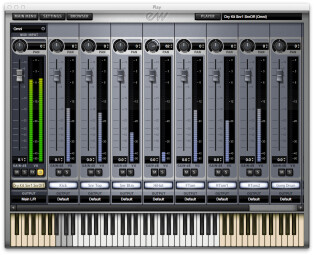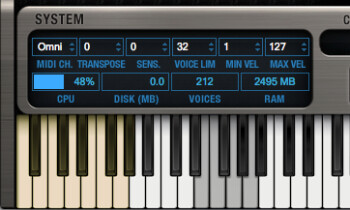EastWest's latest production, Ghostwriter, is a virtual instrument that's the result of a collaboration with Steven Wilson, a key figure in the prog and ambient music scenes in recent years. Is Wilson's name there mainly for marketing purposes, or is this joint effort a true masterpiece?
Our recent iZotope BreakTweaker review was the perfect opportunity to talk about collaborations between artists and software developers or hardware manufacturers. So we won’t go into that again. even if the subject of this review is the fruit of the joint work of Doug Rogers, founder of EastWest, and Steven Wilson, an essential artist, musician and producer well-known for his involvement in such diverse projects as Porcupine Tree, No-Man, Bass Communion, and Storm Corrosion, as well as for his mixing and remixing skills (specially in 5.1), not to mention his work as co-producer of artists and bands such as Anja Garbarek, ELP, King Crimson, Marillion, Jethro Tull, Caravan, etc. Even if it is all clearly prog rock (or neo-prog rock) oriented.
|
We are about to discover a co-production that promises a lot, given the personality of its two creators: On the one hand Rogers and his entrepreneurial methods — a mix of audacity, undeniable technical know-how and commercial skills — and, on the other, Wilson and his artistic vision, combined with his flair of a producer who knows to be at the right place at the right time. The name of their common product is somewhat equivocal, since a Ghostwriter is not really a source of inspiration, as the software is presented. Especially considering that claiming authorship of musical work created by someone else — be it of previously existing compositions or works actually made by a non-credited team — is still one of the problems of the music and film industries.
But let’s not get distracted by the name of the product, examples of dubious and even catastrophic practices in this regard are plentiful in all sectors. Let us rather look into what this new library has to offer, as well as the innovations in Play, the publisher’s player, which just got updated.
Introducing EastWest Ghostwriter
Although EastWest opted not long ago for delivering its products via download, the size of Steve Wilson’s Ghostwriter isn’t the most adequate for such approach, unless you have the fastest Internet connection possible. The instrument is 60Gb+, which makes it worthy of being delivered in DVD ($395) or in the form of a stylish Western Digital USB 3 HDD (with USB2 adapter, $465). The publisher notes that the latter can’t be used as playback media for the samples unless you have a USB 3 connection, since the speed of USB 2 is not enough to handle correctly the presets’ requirements. So, you will have to save the Ghostwriter Instruments and Ghostwriter Samples folders on a fast drive, 7200 rpm minimum and FireWire 800. Internal solutions via SATA, SSD or an external Thunderbolt drive will also do the trick.
Make sure to download the latest Play version (4.1.8 at the time of this review) and to tick the Ghostwriter installation in the appropriate menu. Authorization is still done via iLok. EastWest recommends using a recent computer and OS, as well as a good amount of RAM. After installation (the installation program is still not entirely compliant, so you’ll have to open it with a right click on Mac), you’ll have at your disposal a standalone application, as well as 32– and 64-bit AU, VST and AAX plug-ins.
A full band
Before exploring the Play interface (it’s impossible to ignore the new features), a quick look at the structure of the library makes it clear that the creators wanted to provide a full band instrumentation, including guitars, basses, pianos, drums, vocals, and the classic Misc (for everything else). We’ll come back to this later on.
As usual, the interface is customized (but still rather big, which is a problem when used with notebooks). However, it’s the unusual modules that will catch your eye: To the left, a delay called EP-1 and, to the right, an Amp and a Reverb (different than the one we are used to). Most of the usual controls are included (and identical), except for several modifications. The filter, for example, changed from a resonant low-pass to virtually a bandpass, thanks to the presence of a low-pass and a high-pass filter. There are also two tuning controls on the GUI, by semitones (± 24) and cents (± 50), like on the The Dark Side.
The Delay and ADT disappeared to give way to an EP-1, which aims to be an Echoplex emulation. In terms of controls, you have Flutter, Drive, delay time (that can be synced to the tempo of Play or to that of the host, from a thirty-second note up to two bars), number of repetitions, and level. It is rather effective, and it also emulates the behavior when you modify the delay time in real time (which is the least you can do if you pride yourself on doing analog).
Here are some examples taken from a guitar preset, a Tele D.I., with different Flutter, Drive, Sync, etc., settings.

Fairly good. With the exception of a rather incomprehensible problem: The automation parameters in Logic (I suppose the same happens with other DAWs) are the same as those of older effects (ADT, Delay, different filters, etc.). Fortunately, MIDI Learn works correctly. We are always surprised by such dichotomies that characterize EastWest products, especially software-wise: On the one hand, the samples are of an excellent quality, it is clear from the sound that the recording was done with a lot of care, but on the other hand you have the loops and the loop points, or the sometimes merely acceptable functionalities of Play (if you consider the features promised in the beginning that never did arrive…), when they are not simply botched.
Moving on with the new features, you have an Amp, with Drive, Bass, Middle, Treble, and Master controls, for 80 different amp models. There is no indication of the technique used, but I guess they used convolution for the characteristics of the amps and the mics (stated in the name of the preset), and the usual algorithmic techniques for the rest.
Since it is used in many presets, in the following example you’ll hear guitars and basses with and without the amp (sometimes with the EP-1 and reverb). You can even get some sort of feedback from time to time and the sound design possibilities are quite varied, thanks in part to the pre- and post-EP-1 routing of the reverb.

These two well-accomplished modules are exclusive to Ghostwriter for the time being, but I’m sure they will eventually be available in more EastWest instruments.
Complete effects
The reverb features pre- or post-EP-1 routing and an In/Out button (in the first case, the Volume button increases the input volume into the reverb, while in the second, it controls the output volume from the reverb), which you can adjust one after the other simply by engaging the switch — very nice. Again, EastWest stuffed its reverb with IRs (726 more!), and that applies to all owners of the SSL/EW FX Global Suite, which includes Ghostwriter (yahoo!). However, they won’t be available for other Play instruments without buying a license, currently being sold for $99 (not much yahoo after all…).
You will almost find the equivalent of a QL Spaces, except for the separate Dry and Wet controls. The list of IRs strongly recalls that of the publisher’s reverb, which, besides the effects, includes the True Stereo as well as the HDIRs.
The biggest innovation in Play 4 is, obviously, the mixer, which provides as many channels with Solo, Mute and Pan controls as there are instruments loaded. It also displays the effects and can open separate tracks (in the case of a drum kit, for example), besides providing monitoring. Plus, it offers the possibility to change MIDI channel, to choose from nine pairs of stereo outputs and select the instrument available on the virtual keyboard (but unfortunately not from the master keyboard) with a simple click on the preset name.
Regarding the Channel Strip (with Gain, Filter, LF and HF plus two parametric EQs, Compressor, Gate/Expander, and Output controls, plus all possible routings), Transient Shaper and Stereo Bus Compressor, they are directly licensed and provided by SSL ─ they are taken from the native version of their Duende plug-ins. The only drawback is that this suite can only be used on the main instrument tracks and not on the separate elements (for instance, all kits can be mixed element by element, but you can’t insert the suite on any of the elements, because it can only be placed on the kit’s main bus). Watch out for CPU load when you start to add effects and the reverb, especially as Play is not what you would call a role model in terms of resource optimization, regardless of whether you choose disk streaming or decide to load the samples into the RAM.
Instruments by the dozen
One of the first thing you’ll notice is that EastWest and Wilson were very generous by providing 800 instruments and presets (the concept of “preset” is important, because a single instrument can have several presets). Those of you who are curious about the presets can download the user manual from the EastWest website, which will spare us a long and tedious description here.
Just for a change, we’ll use the two demos provided by EastWest to showcase the instrument’s potential, whose sound is authentic as far we can tell (according to EastWest, they don’t feature any instruments nor effects that aren’t included in Ghostwriter, but we can’t guarantee the absence of compression nor the use of reverbs on the bus), which will certainly bring to mind some ambiances and sounds of the different bands and projects Wilson has been part of. So, here’s the first demo:

And now the second one:

You can also check out this short video briefly featuring Wilson and Rogers at work.
Going back to the demos: You can clearly hear the limitations of certain sounds. For example, we really appreciate the presence of kits including snare drums without snares, but sometimes you can’t help the impression of a single sound being repeated. We also appreciate the possibility to work on the kit mixes instrument by instrument in the Mixer view, including the overheads’ (OH) level, as well as the bleed.
Here’s an example of a kit without OH nor Bleed, then with OH only, then Bleed only, and, finally with both.

The kits provided are of excellent quality, the presets are well-conceived, but we still have two criticisms: The snares at low velocities have too much attack, which makes it impossible to get realistic-sounding ghost notes (you can get around this by loading the preset twice and modifying the envelope generator applied to the volume) and, especially, the panning of instruments, which is inverted on the OH and the instrument tracks themselves! This means that, for example, the hi-hat might be on the right side of the stereo field on its track, while it is on the left side on the OH.
Conclusion
In general, this collaborative effort between Wilson and EastWest is a successful one, even if it’s very specialized. Musicians looking for versatile or all-purpose sounds won’t find that here, but those who want to approach, in one way or another, the sound atmospheres usually associated with Steven Wilson will be satisfied. The innovations in Play 4 allow you to work with sound in more detail, especially thanks to the two effects, the delay and the amp simulator.
The few drawbacks don’t outweigh the pleasure of using Ghostwriter, which is good news, considering that certain EastWest instruments had recently left us with the impression of being unfinished or imperfect. In this case, the sounds spark your creativity, which is rare enough to be worth mentioning. Good job!

